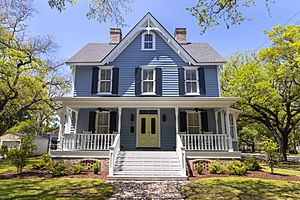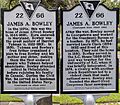James A. Bowley facts for kids
Quick facts for kids
James A. Bowley
|
|
|---|---|
| South Carolina House of Representatives | |
| In office 1869–1874 |
|
| Personal details | |
| Died | January 30, 1891 |
| Political party | Republican |
| Spouse | Laura Clark |
| Military service | |
| Allegiance | |
| Branch/service | Union Navy |
| Years of service | 1863–1865 |
| Rank | Boatman |
| Battles/wars | Civil War |
James Alfred Bowley (born around 1844 – died January 30, 1891) was an important person in South Carolina. He was a teacher, lawyer, judge, and politician. He also published a newspaper. James Bowley escaped slavery in Maryland with help from the famous Harriet Tubman. He later served in the U.S. Navy during the Civil War. After the war, he moved to Georgetown, South Carolina. There, he taught in schools and was elected to the South Carolina House of Representatives. His old home in Georgetown, where he lived with his wife Laura Clark, is now a historic site.
Contents
Early Life and Escape to Freedom
James Bowley was the son of John and Kessiah Bowley. His mother, Kessiah, was the niece of Harriet Tubman. They were very close, almost like sisters. James, his mother Kessiah, and his sister Araminta were enslaved by Eliza Ann Brodess in Dorchester County. This was the same person Harriet Tubman had escaped from just two years earlier.
In December 1850, Harriet Tubman heard that Kessiah and her children were going to be sold at an auction. Tubman quickly went to Baltimore and made a plan with Kessiah's husband, John. During the auction, John Bowley managed to buy his own family without anyone realizing who he was. After the auction, the three enslaved people were quickly hidden in a safe house nearby.
Amazingly, the Bowleys sailed a small boat up the Chesapeake Bay to Baltimore. There, they met Harriet Tubman again. From Baltimore, they were guided to Philadelphia. However, a new law called the Fugitive Slave Act made it dangerous for escaped enslaved people to live in "free" states. So, Kessiah, John, and Araminta soon traveled to Canada. They settled in Chatham, Ontario, where many other Black people who had escaped slavery lived. James, however, stayed in Philadelphia with Harriet Tubman for a while to go to school. Tubman spent about half of her money to help pay for her nephew's education.
Serving in the Civil War
In 1863, James Bowley joined the Union Navy. He served as a Boatman on a ship called the USS Genessee. He helped the Union during the Civil War.
Career and Public Service
After the Civil War ended, James Bowley wanted to help newly freed enslaved people. Around 1867, he became a teacher for the Freedmen's Bureau in Georgetown, South Carolina. This organization helped formerly enslaved people adjust to freedom.
Bowley quickly became an important person during the Reconstruction era. This was a time when the Southern states were rebuilt after the war. By 1870, he had married Laura Clark, who was from Georgetown. He was listed as a "school commissioner," meaning he helped manage schools. He also owned some property.
Elected to the State Legislature
In 1869, James Bowley ran in a special election for a state representative seat in Georgetown. He ran as a Radical Republican and won by a large number of votes. He was re-elected in 1870 and again in 1872.
As a lawmaker, Bowley faced many challenges. He led the Committee on Ways and Means. This group decided on tax laws and how the state would collect money. Some newspapers at the time, which were against Black politicians, made unfair comments about him. They suggested he was not smart enough or could be easily bribed.
Becoming a Lawyer
In 1872, James Bowley became the second Black lawyer to practice law in Georgetown courts. He studied law for two years under Macon Bolling Allen in Charleston. After passing his law exam, he was allowed to work as a lawyer.
Starting a Newspaper
In 1873, Bowley started a weekly newspaper called the Georgetown Planet. This newspaper focused on politics, literature, and science. It was the only Republican newspaper in Georgetown at the time.
University Trustee
Also in 1873, James Bowley was named a trustee for the University of South Carolina. At this time, the university was starting to allow Black students to attend. Fear of Black students joining caused many white students to leave. Even after making tuition free, Bowley and other trustees had trouble filling the university's seats. They had to convince students from other universities, like Howard University, to transfer. By 1875, about 90% of the students were Black.
Political Challenges
James Bowley faced many political difficulties. He had a public disagreement with another Republican, William H. Jones. This disagreement made it harder for Black politicians during Reconstruction. Newspapers at the time often made these conflicts seem worse. They wanted to show that Black leaders were not capable.
The disagreement between Bowley and Jones started because Bowley did not agree with Jones's support for Benjamin Franklin Whittemore. Whittemore was later criticized for selling appointments to the U.S. Naval Academy. Because of this, Jones tried to stop Bowley from being re-elected in 1872. However, Bowley won the election with help from Joseph H. Rainey.
In 1874, Jones tried again to defeat Bowley. Jones sent his supporters and the local militia he led to disrupt Bowley's political meetings. This caused a lot of tension. One night, a group of Bowley's supporters attacked Jones's house. James Bowley was taken to jail for his safety. Later, a mob of Jones's supporters damaged Bowley's home.
Eventually, both Jones and Bowley agreed to a "treaty of peace." This agreement was overseen by Macon Bolling Allen. As a result, neither man was charged with crimes for their part in the conflict.
Bowley lost his seat in the South Carolina House of Representatives in 1874. He continued to be involved in elections. For example, he worked as an Elections Clerk during the 1876 National Congressional election.
Later Years and Legacy
After the Reconstruction period ended, James Bowley went back to teaching in Georgetown schools. As late as 1888, he was teaching at the 'Colored Graded School' in Georgetown.
Bowley also worked as an "enumerator" for the 1890 U.S. Census in Georgetown County. This meant he helped collect information for the national count of people.
James Bowley died on January 30, 1891. At the time of his death, he was serving as the Judge of Probate for Georgetown.
In 2019, a historical marker was placed near the home he built in Georgetown, South Carolina. This marker helps people remember his important life and contributions.
See also
Images for kids



